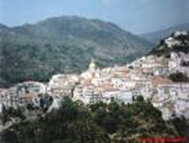|

Some information about my town and it's territory
by Maria Stella Dodaro
Like Rome, Cosenza has been built on seven hills. Cosenza is the most cultivated city in Calabria and it also has the greatest natural beauty.
On one side it looks to the mountains, on the other one to its two seas, the Tyrrhenian and the Ionian.
Camigliatello is the pearl of that green horizon which embraces the pines of the Fossiata Valley, Croce di Magara, Lorica, San Giovanni in Fiore and Mount Curcio, where one can breath the air of both seas.
These places are lovely in Winter as well as in Summer. The ski-lifts carry hundreds of youngsters up to the slopes on the high ridge of Mount Curcio. Then, in half an hour, going downhill on the highway,
you come to the shores of the Tyrrhenian - to Cetraro, San Nicola Arcella, Diamante or Belvedere - . the Ionian Sea is not far away either. There, Cosenza echoes with names from the old legends - the blue sea of Aphrodite,
the glories of Sybaris surfacing once more after two thousand eight hundred years, as the Crati River is drained by voracious water-pumping machinery. There you will find Rossano, Corigliano, Amendolara, Trebisacce,
Villapiana and the archaeological area of Timpone della Motta. Cosenza also has a satellite, Rende, which is the pride of the surrounding area. Rende stands for the future with its nearby experimental university.

Short History of Cosenza
by Ersilia Peta
Cosenza is a very ancient town. It was the capital of the Bruttii people, and later it came under the influence of the Greek civilization.
In 204 BC it was conquered by the Romans and became an important communication centre along the Via Popilia, connecting Rome to Reggio and Sicily.
Then it was conquered by different populations, from the Nordic Goths and Longobards to the oriental Byzantines.
A legend tells us that the Goth king Alaric died here in 410 A.D. and was buried with all his treasure, somewhere in the Busento river.
We know nothing about the transition from Gothic to Byzantine and Longobard domination, but surely in 663 AD the town was Byzantine.
Since the first half of the eleventh century, Calabria became a Norman feudal dukedom and Cosenza was its capital. Later, under the Hohenstaufen reign, the town became the seat of the Court of Calabria.
The Emperor Frederick II had a particular interest in the town: he promoted construction and economic activities thanks to the organization of an important annual fair. It still exists nowadays, though transformed, and it takes place every 19th of March.
After Frederick II's death, Cosenza fought against the Angevin domination, supported by the clergy. The town was involved in the fight between Angevins and Aragonese.
In the 16th century, Cosenza became the centre of a flourishing Academy and here in the 16th century the philosopher Bernardino Telesio (1509-1588) was born.
He was an important Italian philosopher and a natural scientist and was one of the most renowned members of the Accademia Cosentina. From 1806 to 1815 Cosenza fought in an unequal struggle against the French domination.
Cruel suppressions characterized that period and in 1813 in the town, which became a cradle of the Carbonari secret societies, many rebels were executed, as the Bandiera Brothers, who were killed together with some of their followers in the Vallone di Rovito in Cosenza.
In 1860, some months after the rapid and heroic deeds of Garibaldi's troops, a plebiscite proclaimed the annexation of Calabria to the new Kingdom of Italy.
Even nowadays Cosenza is open to other cultures, in fact it is involved in lots of different activities, joined by people from everywhere.

Date of inclusion on the website: 12.05.2009
|






















